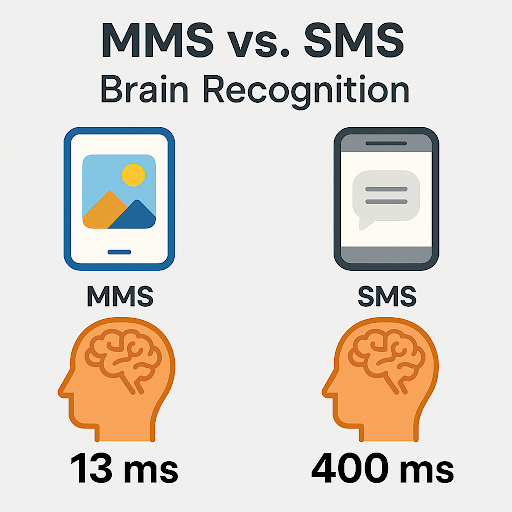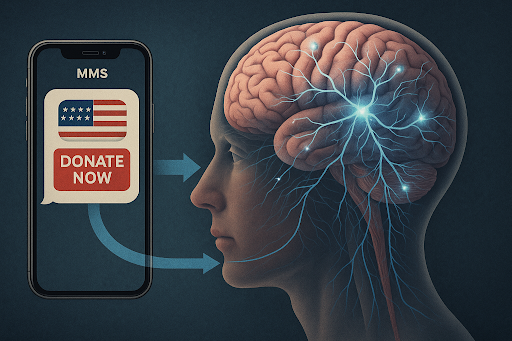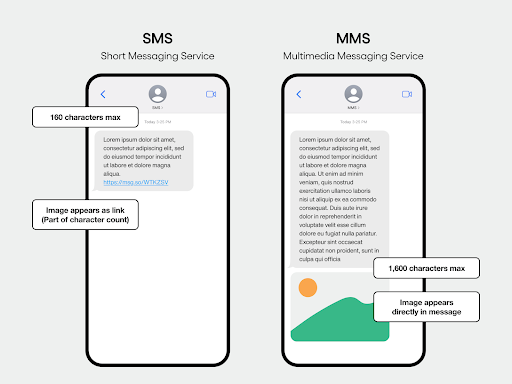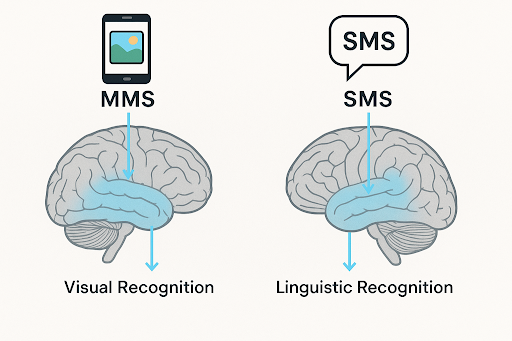Why MMS Outperforms SMS: The Neuroscience Behind Visual Messaging
In the world of digital messaging, attention is currency — and milliseconds are everything. Whether you’re running a political campaign, driving donations, or mobilizing advocates, your message needs to land, be understood, and inspire action — often in the blink of an eye.
That’s why MMS (Multimedia Messaging Service) is quickly overtaking traditional SMS (Short Message Service) as the smarter choice. Backed by decades of neuroscience research, MMS doesn’t just “look better.” It leverages how the brain is wired — to see, process, and remember images faster and more deeply than words.
And science proves it.
 The MIT Study: 13 Milliseconds to Make an Impression
The MIT Study: 13 Milliseconds to Make an Impression
Let’s start with a groundbreaking fact: in 2014, neuroscientist Mary Potter and her team at MIT found that the human brain can process and identify visual images in just 13 milliseconds.
That’s not a typo. 13 milliseconds.
That’s faster than the blink of an eye. Faster than you can consciously register a thought.
In the study, participants were shown rapid streams of images — and still correctly interpreted what they saw at speeds that shocked even the researchers. The conclusion: the brain doesn’t just perceive visuals quickly; it understands and interprets them almost immediately.
“The brain doesn’t just perceive visuals quickly; it understands and interprets them almost immediately.”

Now think about what that means in the real world:
📱 A person glances at a message on their phone for less than a second — maybe 400 milliseconds. If it’s plain text, their brain is still starting to decode it. If it’s MMS with a compelling image or video thumbnail? The message is already absorbed.
This isn’t a minor difference. It’s the difference between being seen or being skipped.
 Harvard Study: The Brain’s Default Is Visual
Harvard Study: The Brain’s Default Is Visual
If the MIT study proves that images are processed faster, the research from Harvard University takes it one step further — showing that visual thinking isn’t just faster, it’s dominant.
In a 2017 study led by cognitive scientists Elinor Amit and Evelina Fedorenko, participants were assigned verbal reasoning tasks and explicitly instructed to think using words. Despite this, their brains consistently formed spontaneous visual images — even when they were trying not to. In short: the act of visualizing occurred involuntarily.
This reveals something profound about human cognition:
The brain defaults to visual processing — even when instructed otherwise.
This means that when you send a multimedia message (MMS) instead of a plain-text SMS, you’re not just delivering your content faster (as shown by MIT). You’re delivering it in the format the brain naturally prefers.
Even when we engage in verbal or linguistic tasks, visual cognition creeps in. That’s not accidental — it’s evolutionary. Our visual system predates written language by hundreds of thousands of years, and our brains have evolved to prioritize rapid, image-based understanding over slower symbolic interpretation like text.
So when you include visuals in your messaging, you’re not just enhancing design — you’re tapping into the brain’s most efficient channel of comprehension and memory.

📉 Why Text Alone Falls Short
While SMS messages are widely read — with open rates over 95% — most are only glanced at, not fully processed. The brain’s path to understanding text is slower and more layered than visual input.
Here’s how the process works:
- ~100 milliseconds – The brain begins by identifying basic letter shapes
- 150–200 milliseconds – It accesses lexical memory to recognize individual words
- 200–400+ milliseconds – It starts semantic processing to assign meaning
That’s a complex, multi-step decoding process — and it takes precious time. When your message is text-only and your recipient is glancing quickly (maybe between tasks or notifications), they may move on before comprehension even begins.
By contrast, MMS front-loads meaning. A strong image can bypass those steps and be processed holistically and instantly — often in the same 13-millisecond window identified by MIT.

⏱️ Visuals vs. Text: A Timeline of Processing Speeds
Let’s compare how the brain handles visuals versus text side-by-side:
| Cognitive Stage | MMS (Image/Video) | SMS (Plain Text) |
|---|---|---|
| Initial Perception | 13 ms (MIT Study) | ~100 ms (letter shape recognition) |
| Word/Form Recognition | — | 150–200 ms (lexical access) |
| Semantic Meaning | 13–50 ms (instant) | 200–400+ ms (semantic processing) |
| Emotional/Contextual Impact | Immediate | Slower, layered, dependent on reading speed |
 As this timeline shows, textual comprehension takes multiple steps and significantly more time, while visuals are recognized and emotionally processed almost immediately. For campaigns or causes that depend on urgency, clarity, or emotional connection — the advantage is overwhelming.
As this timeline shows, textual comprehension takes multiple steps and significantly more time, while visuals are recognized and emotionally processed almost immediately. For campaigns or causes that depend on urgency, clarity, or emotional connection — the advantage is overwhelming.
While SMS may be opened 95% of the time, most messages are only glanced at. If it’s text-only, the brain may not even get past letter recognition before the recipient has moved on or As science would show us more than likely focus and pick out one or two words and formulate an opinion. But with MMS, the message lands instantly, often in less time than it takes to read a single word.
📈 Real-World Results: Fundraising and Engagement
The neuroscience is clear — and so are the campaign results:
- MMS generates 20–40% higher click-through rates than SMS
- Visuals increase emotional engagement, leading to higher donation conversions
- Messages with photos, logos, or emotive thumbnails are more likely to be remembered and acted upon
- Videos or GIFs in MMS can tell a story in seconds, bypassing long text and keeping the viewer engaged
For political and nonprofit campaigns, this translates into higher ROI and better supporter retention — not just more clicks, but more impact.
📊 MMS vs. SMS: Key Fundraising Metrics
Click-Through Rates
While SMS messages had a higher median click-through rate (1.56%) compared to MMS (0.97%), MMS consistently achieved higher conversion rates — meaning more recipients who clicked went on to complete the desired action (e.g. donating).
It is hypothesized that this is due to the rapid image recognition and comprehension enabled by MMS. With visuals, subscribers are likely better informed about what they’re clicking into, reducing drop-off and increasing follow-through.
Average Gift Amount
MMS also outperformed SMS in average donation size.
- SMS average gift: $36.47
- MMS average gift: $38.43
This suggests that MMS doesn’t just drive more meaningful engagement — it also leads to larger contributions, likely due to the emotional and visual context delivered before the user even clicks.

Opt-Out Rates
MMS messages saw a slightly higher opt-out rate (0.63%) than SMS messages (0.37%).
We surmise this too is tied to the faster cognitive processing of images. When recipients immediately understand the nature of the content via a visual, they’re able to form a quicker — and sometimes final — opinion. In other words, MMS accelerates decision-making, for better or worse.
Source: MissionWired 2024 Nonprofit Text Messaging Insights Report
📈 MMS Enhances Fundraising Outcomes
- Response Rates: In testing, MMS messages increased fundraising response rates by 30%–50% over standard SMS messages. M+R
- Donor Engagement: The Human Rights Campaign found that text message subscribers were 2.5 times more likely to donate than non-text message subscribers. Upland Software
- Donation Likelihood: The Humane Society of the United States observed that members who received a MMS text message reminder to donate were 77% more likely to give. Upland Software
🎯 Strategic Use of MMS in Fundraising
- Visual Appeal: MMS messages allow nonprofits to include images, GIFs, and videos, making messages more engaging and helping to convey the impact of donations effectively.
- Personalization: Using merge tags in MMS messages enables organizations to personalize content, such as including the recipient’s name or previous donation amounts, fostering a stronger connection with donors.
- Time-Sensitive Appeals: Incorporating countdown clocks or donation thermometers in MMS messages can create a sense of urgency, encouraging prompt action from recipients.
 🧠 Cognitive Advantages of MMS
🧠 Cognitive Advantages of MMS
The effectiveness of MMS in fundraising is further supported by cognitive science:
- Rapid Processing: The human brain can process images in as little as 13 milliseconds, allowing visual content to capture attention almost instantaneously. info.missionwired.com
- Visual Dominance: Studies from Harvard University indicate that the brain defaults to visual processing, even when engaging in verbal tasks, highlighting the innate preference for visual information. info.missionwired.com
💡 Why This Matters for Campaigns and Advocacy
We’re not just choosing between old and new technology. We’re choosing between cognitive friction and cognitive flow.
- SMS asks the brain to decode — slowly, and with effort
- MMS communicates in the way the brain prefers — fast, emotional, and memorable
 In today’s crowded attention economy, you only get one chance to capture attention. And that window might only be 500 milliseconds wide.
In today’s crowded attention economy, you only get one chance to capture attention. And that window might only be 500 milliseconds wide.
With MMS, you can make your point in 13.
📚 Final Takeaway: 13 vs. 400 — The Science Behind the Shift to MMS
At the core of this conversation is one simple but profound contrast:
- Visuals can be processed by the brain in as little as 13 milliseconds
- Textual meaning (semantic processing) can take up to 400 milliseconds or more
That’s a 30x speed advantage for images — and it happens in a space of time so small, most of us aren’t even aware of it. In a fast-paced attention economy, especially in political or fundraising messaging, every millisecond counts. MMS gives campaigns the power to deliver a message that connects before the recipient even starts reading.
Add to that Harvard’s findings — that the brain instinctively forms visual images even when asked to think verbally — and the argument becomes airtight: we are visual thinkers by nature, and our communication strategies should reflect that.
🏁 The Conclusion: Science Settles the Score
Visual messages aren’t just prettier — they’re faster, stronger, and better aligned with how we think. When you’re trying to reach voters, donors, or advocates, don’t let your message get lost in a wall of text.
The brain is built for visuals. MMS is built for the brain.
Source Citations
- 📚 MIT Study Title:
Detecting meaning in RSVP at 13 ms per picture - Authors:
Mary C. Potter, Bradford Wyble, Carl Erick Hagmann, Emily S. McCourt - Published in:
Attention, Perception, & Psychophysics, 2014 - DOI:
10.3758/s13414-013-0605-z - Amit, E., & Fedorenko, E. (2017). Spontaneous visual imagery during verbal reasoning. Harvard Gazette
- Word Recognition and Visual Word Form Area, Wikipedia
- Internal campaign benchmarks and performance studies from mobile messaging platforms (MMS vs SMS)
- Source: MissionWired 2024 Nonprofit Text Messaging Insights Report info.missionwired.com


